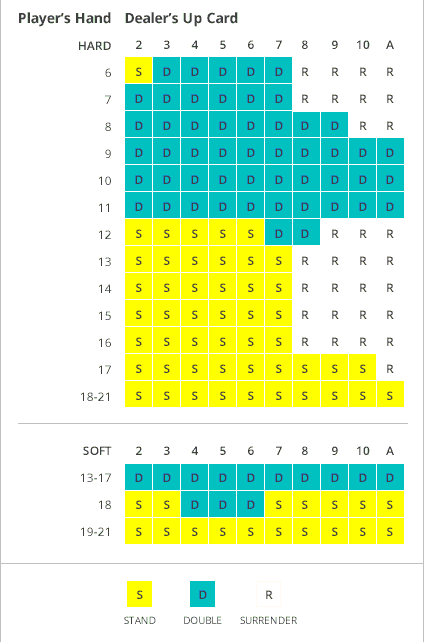This is the Spanish version of Blackjack. There are many different house rules, some that enhance the house’s edge and some that benefit the player. Keep in mind that the house will always have an edge but some variations reduce it to 0.40%!
The one biggest difference between Spanish 21 and regular Blackjack is that the four tens are removed from the deck. This increases the house’s edge so there are other rules changes that benefit the players.
The game is usually played with 6 or 8 decks in a shoe or a Continuous Shuffling Machine. This allows for the “same” card to be played to more than one player on the same hand.
Basic Strategy Card for Spanish 21
The Play of the Hand
*** The dealer deals two cards to each player and to himself. The dealer’s hole card is face down.
*** If the dealer has an ace or a picture card showing s/he will check for 21.
*** Before the dealer checks for 21 with an ace showing, s/he offers insurance. Insurance pays 2-1 as in Blackjack but with the tens removed the true payout should be 3-1. Insurance in Spanish 21 is a poor bet.
*** Dealer’s 21 beats all hands automatically except a player’s natural 21 which beats the dealer in most casinos. This is one rules change that clearly favors the players.
*** If there are no naturals, play continues as in Blackjack.
*** If a player busts s/he loses immediately.
*** As the hand continues, the player and the dealer may both get 21. In most casinos, the player wins.
Players’ Options during the Hand
*** Players may split cards of equal rank. They may split three times, creating four hands.
*** Players may double down at any time. This means that if a player received 2 and 3 and then 6 s/he may then double down on 11.
*** Players may re-double down. For example, a player received 2 and 4 and dealer shows 5. The player doubles down and gets a 3. S/he may re-double down on 9. If s/he then gets a 2 s/he may double down again on 11. House rules vary for this aspect, so find out in advance what the rules are for redoubling down.
*** Late surrender is usually allowed. This means that a player feels his hand is a loser so s/he surrenders half the bet and is removed from the hand.
*** A special type of late surrender is called double down rescue. Here, the player has doubled down but has a poor hand. S/he may take back the double down portion of the bet but surrenders the initial bet.
*** Players who wish to learn the arcana of Spanish 21 strategy must remember that in some casinos the dealer hits on soft 17 and in others the dealer sticks.
Special Hands and Payouts
*** A five-card 21 pays 3-2.
*** A six-card 21 pays 2-1.
*** A seven-card (or greater) 21 pays 3-1.
In most casinos, the above bonuses are not paid after splitting or doubling.
*** A 21 reached by a combination of 6-7-8 or 7-7-7 unsuited pays 3-2. Remember, with so many decks, the combinations could be suited.
*** If these two combinations for 21 are suited they pay 2-1.
*** If they are suited in Spades they pay 3-1.
*** Just to whet the appetite, a suited 7-7-7 with a 7 showing for dealer pays $1000- $5000, depending on the player’s initial bet.
Summary
Many Blackjack players also enjoy Spanish 21 for both its similarity to Blackjack and the differences created by the removal of the tens. If you can count cards, you reduce the house’s advantage more in Spanish 21 than in Blackjack. At the very least, Spanish 21 is a great change-of-pace.




